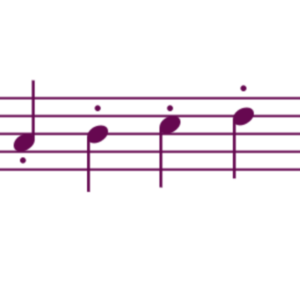Collé violin bow stroke explained + 3 exercises
What is collé bowing on the violin?
Collé is a technique where the fingers and wrist make a circular motion resulting in an active, off-the-string bow stroke with a firm sound. It most frequently done near the frog.
Collé vs Spiccato
Since it is a short off-the-string stroke, collé is sometimes confused with spiccato. There are similar techniques involved, but collé is usually for slower tempos or articulating individual notes, whereas spiccato is for faster and longer passages. Go here to read more about spiccato violin bowing.
Why should you practice collé bowing on the violin?
Collé bowing and the exercises that lead to it described later in this article are not only useful for playing collé in repertoire. Collé is great to improve your bow hand flexibility, bow control and smooth bowing. Practicing collé will improve your overall violin bowing technique and tone.
Collé sheet music notation
 In sheet music, you will see staccato dots above the note but you probably won’t find the word collé written into the part. Rather, it is stylistically implied or might be an artistic choice. The finger/wrist action in collé gives a very strong articulation to the beginning of a short note so that it doesn’t get lost in the texture.
In sheet music, you will see staccato dots above the note but you probably won’t find the word collé written into the part. Rather, it is stylistically implied or might be an artistic choice. The finger/wrist action in collé gives a very strong articulation to the beginning of a short note so that it doesn’t get lost in the texture.
Collé can be described as “bowed pizzicato”
This describes how short the contact should be, and that in a sense the bow “plucks” the string. The bow must always start from the string with flat hair. If the bow is not into the string, the articulation will not be loud enough for the note to pop.
How to learn collé bowing on the violin?
Collé might feel awkward and difficult at first because it requires a high level of hand flexibility. It is helpful to start learning difficult techniques away from the violin at first to lower frustration levels.
3 collé exercises
Here is a progressive sequence of exercises you can do to learn collé:
- Put your fingers together as if you were holding an invisible bow. Without dropping the “bow”, curve your fingers in towards your lowest row of knuckles, then straighten them down away from your palm. This should be a very active motion, but allow your tendons to be relaxed. Do this several times every day to increase dexterity, and then try doing it while holding a pencil in bow position.
- Now try the same thing with your bow, but without the violin. Balance the tip of your bow on your other hand. Can you do the motion fluidly without dropping the bow? (Hint: don’t grip tightly.) Is your thumb rounded in the up position?
- Place your bow on an open string at the frog. Now here’s an important detail: If you’re about to do an upbow, your fingers should be straight. If you’re about to do a downbow, your fingers should be curved. The wrist will move through the stroke as well. For example, if you firmly set the frog on the string in the fingers curled position, quickly shoot your fingers down, lifting the bow from the string as you do so. The goal is to get a clear but very short and slightly percussive sound. Do this very slowly on open strings only at first, watching in a mirror to see if your bow stays straight.
Another great exercise for bow hand flexibility is the Thibaud exercise you can find here.
Collé doesn’t get talked about much, but it is a vital part of the violinist’s toolkit. Facilitating finger/wrist dexterity makes it possible to play fast with clarity. For example, listen to this passage from Lalo’s Symphonie Espagnole. The short, strong up bows at the frog are collé.

Hi! I'm Zlata
Classical violinist helping you overcome technical struggles and play with feeling by improving your bow technique.
Improve your violin bowing technique with these lessons and articles:
Do you want to know every possible bowing technique on the violin? Watch this video with 102 violin bowing techniques.
The basis for all bowing techniques is to bow smoothly. This video lesson will help you with that.
A proper and relaxed violin bow hold will help a lot improving your bowing technique and sound. Read this article.
Take bowing technique lessons with Zlata
Join my Violin Bowing Bootcamp to build a great basic technique, make a beautiful sound and learn the most common bow strokes.
Join Bow like a Pro for an extensive curriculum all things bowing.

Hello,
I just wanted to say that for this article, when I watch the movie, it’s not clear to me what exactly collé is, even watching about a third of it. It just isn’t obvious to me which of the many bowings you are talking about because there are so many, and I am not sure at which time the collé starts.
Raymond